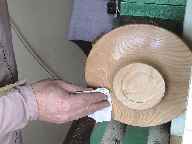CYNNYC
Member
Very recently watched a pro wood turner at a demonstration doing some fantastic apples and bits and bobs.
His finish was hard glossy and smooth and dry.
He applied a mix of 40% sand sealer and 60% thinners both cellulose based by chestnut.
Then removed excess with 0000 wire wool and left for a few mins to dry.
He then applied record speed and ease friction polish thinly with increasing pressure.
After just a few seconds the result was amazing.
I was so impressed I spent £30 on the same finishes by same manufacturers and carried out exactly the same procedures.
Im disgusted with my attempts to reproduce his finish, I cannot get even close, I have persisted and tried many variants and methods
with no degree of success.
I am working with very small pieces ie ringboxes. Problems = lines of polish, bare areas of wood, satin finish instead of gloss.
Any / all usefull comments appreciated.
Thank you all in advance.
CYNNYC
His finish was hard glossy and smooth and dry.
He applied a mix of 40% sand sealer and 60% thinners both cellulose based by chestnut.
Then removed excess with 0000 wire wool and left for a few mins to dry.
He then applied record speed and ease friction polish thinly with increasing pressure.
After just a few seconds the result was amazing.
I was so impressed I spent £30 on the same finishes by same manufacturers and carried out exactly the same procedures.
Im disgusted with my attempts to reproduce his finish, I cannot get even close, I have persisted and tried many variants and methods
with no degree of success.
I am working with very small pieces ie ringboxes. Problems = lines of polish, bare areas of wood, satin finish instead of gloss.
Any / all usefull comments appreciated.
Thank you all in advance.
CYNNYC










































